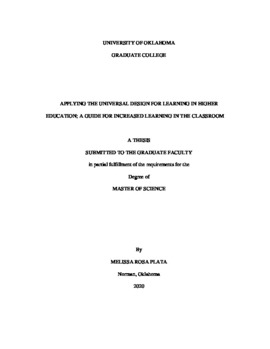| dc.contributor.advisor | Kang, Ziho | |
| dc.contributor.author | Rosa Plata, Melissa | |
| dc.date.accessioned | 2020-05-07T16:44:45Z | |
| dc.date.available | 2020-05-07T16:44:45Z | |
| dc.date.issued | 2020 | |
| dc.identifier.uri | https://hdl.handle.net/11244/324311 | |
| dc.description.abstract | Education is essential for societal progress. Therefore, increasing performance in learning has become a popular research topic. However, determining this has proven difficult as all humans learn differently.
The Universal Design for Learning (UDL) has focused on providing a set of intuitive teaching and course design guidelines that can increase learning (CAST, 2018; Meyer, Rose, & Gordon, 2014). UDL concepts have been implemented in K-12 education levels with successful outputs. However, these techniques effectiveness have been sparsely tested in higher education coursework. A study was conducted for this thesis that strived to determine the effectiveness of the UDL framework when applied in the higher education (HE).
A set of slides implementing the UDL principles were created for this experiment from an existing aviation course. Thirty-six students from the University of Oklahoma participated in studying sample slides from either the UDL inspired content or Original course content. The subjects’ eye movement fixation duration, eye fixation count, pupil size and quiz results, were statistically analyzed to determine significance. The analyzed measures provided a way to quantify students engagement. This served to compare if enhancements using UDL were effective when applied to contents found in higher education. Additionally, a brief exit survey was conducted to further validate engagement and interest from the participants
The results revealed an improvement when UDL contents are applied. Quiz result significantly improved with the UDL inspired contents. Eye movement fixation duration and eye fixation counts were higher for the UDL contents. Participants that had UDL enhanced contents had slightly higher pupil dilation which could be linked to greater focus. Finally UDL participants expressed higher levels of satisfaction and interest in the exit survey.
Results indicated that when UDL contents were applied to learning materials students’ scores improved overall; additionally the longer eye fixation duration and eye fixation counts associates to an increase in attention. Therefore, implementing UDL into the higher education learning process shows promise in enhancing students’ scores and overall attentiveness. | en_US |
| dc.language | en_US | en_US |
| dc.rights | Attribution-ShareAlike 4.0 International | * |
| dc.rights.uri | https://creativecommons.org/licenses/by-sa/4.0/ | * |
| dc.subject | Universal Design for Learning (UDL) | en_US |
| dc.subject | Higher Education | en_US |
| dc.subject | Eye Tracking | en_US |
| dc.title | Applying the Universal Design for Learning in Higher Education; A Guide for Increased Learning in the Classroom | en_US |
| dc.contributor.committeeMember | Allen, Janet K | |
| dc.contributor.committeeMember | Shehab, Randa L | |
| dc.date.manuscript | 2020 | |
| dc.thesis.degree | Master of Science | en_US |
| ou.group | Gallogly College of Engineering::School of Industrial and Systems Engineering | en_US |
| shareok.nativefileaccess | restricted | en_US |

